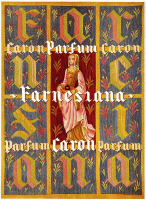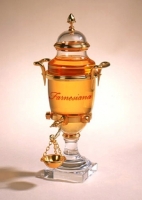

Farnesiana was one of the first modern fragrances inspired by the mimosa flower, that notoriously difficult-to-replicate fluffy yellow bloom. According to Jean-Marie Martin-Hattemberg's volume on Caron, Farnesiana was created by perfumer Michel Morsetti in 1947; its composition includes notes of mimosa, black currant, bergamot, jasmine, violet, lily of the valley, lilac, vanilla, sandalwood, opopanax, hay, and musk (although the Caron website currently only lists mimosa, sandalwood, and hay). The name "Farnesiana" refers to acacia farnesiana, the botanical name for a particular variety of mimosa; it is also, Caron suggests, evocative of Rome's grand Farnese Palace.
That juxtaposition of a simple flower and a Renaissance palazzo seems appropriate to me, since I've always considered Farnesiana a sophisticated comfort scent, an unusual floral-gourmand (or "fleurmand," as I like to call this perfume sub-genre). To my nose, Farnesiana begins with a powdery, pollen-like mimosa note and with accords of sun-warmed hay and grass. Oddly enough, this green-tinged phase reminds me of certain fragrances from Santa Maria Novella, like Ginestra (Broom) or Fieno (Hay), that evoke meadow-like landscapes. Farnesiana's heart opens up to reveal the sweetly resinous opoponax — one of those notes that I might or might not love, depending on the context, but I do like it in Farnesiana. Then there's also a considerable amount of dusty almond with just a hint of fruitiness (the black currant) and a drop of vanilla. I also detect a cool lilac note, although some of the other listed florals are not as apparent to me. The base of the composition includes just enough soft musk to make Farnesiana's far dry-down a refined skin scent for me.
Of course, the issue that I've been skirting up to this point is the question of possible reformulation: has Farnesiana been altered over the years, and if so, for better or for worse? The sample I'm using right now was acquired directly from the Caron boutique in New York City just a few weeks ago, so I'm assuming it's the most recent version. I've only been familiar with Farnesiana for about six years; in my memory, it was a little plusher and more golden when I first sampled it, but the current Parfum still "feels" like Farnesiana to me. However, I haven't sampled any truly "vintage" Farnesiana. Erin, who has gone further back, regretfully calls today's Farnesiana "a pale non-entity"; in Perfumes: The Guide, Tania Sanchez finds little to love in the current fragrance after sampling a 1950s original.
On the other hand, Victoria of Bois de Jasmin thinks Farnesiana's current formulation is very well done, and I tend to side with her on this one. For me, Farnesiana is still an intriguing fragrance, something hard to define, somehow gentle yet moody and changeable. I'd recommend trying it if you usually enjoy soft almondy scents or meadowy-grassy florals, since it combines these two ideas. Of course, if you're already deeply in love with a much earlier bottle of Farnesiana, the current offering might disappoint you — heaven knows, I've had that experience with Caron's Bellodgia — but sometimes, a little ignorance can be bliss.
Caron Farnesiana Parfum Extrait is available in a range of sizes: 7.5 ml ($100), 15 ml ($150), 25 ml ($180), 50 ml ($240), 100 ml ($360), and 200 ml ($520), in glass stopper bottles. For purchasing information, see the listing for Caron under Perfume Houses.
Wonderful review, Jessica, and this sounds lovely. Several years ago, the very first samples I ever ordered from Patty’s business before she was The Perfumed Court, were from Caron. I liked them, but never bought FB’s of any of them, and that, as I remember, was the end of my Caron exploring.
And I agree – if the current version suits you, there is no reason to make your life more complicated by chasing after a vintage version!
Thanks, Rappleyea! I had to “grow into” Caron, other than Bellodgia, which I’ve always loved (my grandmother wore it)… so you may yet find a Caron scent that suits you!
Bellodgia has been my mother’s fragrance for years! Before that it was Rogers & Gallet Blue Carnation.
The Caron’s were too sweet for me if I remember. I think I never revisited the line because of all the lines, that one seemed to have the most negative remarks by perfumistas about reformulation.
I am so on the bandwagon of being perfectly happy to enjoy current formulations if I am none the wiser. I love the current versions of Femme and Jolie Madame, for example.
I have a sample of this but don’t remember if I liked it or not. Will have to re-explore! Thanks for the great review.
What we don’t know can’t hurt us. Or, what the nose didn’t smell, the heart can’t grieve for. 😉
That should be cross stitched and framed! 😀
Very good, Jessica! And I agree, too.
I love Farnesiana! It makes me think of German almond cake and marzipan, both very nostalgic foods for me. I am glad to hear that the current formulation still smells nice. Annick Goutal Eau de Charlotte is another member of the “fleurmand” category which I am enjoying right now. Mimosa, cocoa, and blackcurrant jam, mmmm!
Elizabeth, I’m very fond of Eau de Charlotte, too! Definitely a “fleurmand” worth sampling, for anyone who hasn’t tried it yet!
Great review! You’re point about ignorance of previous formulations is spot on. It is certainly true that if one has become accustomed to perfume over a period of time and the quality of the product is diminished then disappointment is unavoidable. However, if it is an entirely new experience, then its past incarnation is irrelevant. It is perhaps a little unfair the way some perfumes are judged in this regard. Anyway, I love Caron so I am always glad to see this house reviewed!
You articulated that so well! Thanks, BChant.
something has always puzzled me about mimosa…. the mimosa I grew up with was never yellow. I was clusters of pink fluffs with very sensitive fern-like leaves that closed when you touched them and long green seed pods like beans. It smelled like a fruity floral–sorta cherry blossom/watermelon/strawberry scent, the epitome of summertime and picnics under its willow-ish dripping branches…
Is this the same mimosa we are talking about but maybe in a different color?
No, it isn’t the same kind at all. The mimosa everyone tries to reproduce the scent of is the one with yellow powder puffs because that’s the kind that grows in the South of France, where Grasse (the perfume capital of the world, really) is situated. You might want to read this recent NST article: https://nstperfume.com/2011/12/16/5-perfumes-mimosa/
RavynG, we had one of those puffy-pink flowered trees in the front yard of my childhood home, and we always called it a “mimosa.” Apparently it’s really a “silk flower tree,” as clarified in the mimosa post that Bela has linked. But it’s often (erroneously) called a mimosa. I also used to call it a “truffula tree,” as in “The Lorax.” 🙂
Yes! Yes! I call them Dr. Seuss trees–never saw them until I moved to Austin. Here people consider them “trash trees” because they pop up like weeds and suck up all the available water. But I adore them. And they do smell heavenly, though curiously only from a distance.
We also had those trees–the ones with the yellow flowers–in Southern California, where the climate is similar to the south of France. But we called those trees “Acacia trees.” Frederic Malle’s Fleur de Cassie evokes the smell of those trees perfectly to me, and brings back the days when I used up on the hill behind our house, under the acacia tree, writing poetry or making out with my first boyfriend. I have never smelled the Caron fragrance, however, and now I really want to give it a test.
The yellow mimosa from the South of France is originally from Mexico. Back at the end of the 19th century, wealthy Americans, who used to spend winter on the French Riviera wanted to have beautiful flowers to look at and smell when nothing else was in bloom, planted mimosa trees in the gardens of their villas. Et voilà!
I need to retry FM Fleur de Cassie! I remember recoiling from it when I tried it, for some reason… it somehow *upset* me, lol. Need to revisit it.
Fleur de Cassie does not smell like mimosa: there are all sorts of things going on in it as well. I’ve tried a lot of so-called mimosa perfumes and, imo. the only true one is the Diptyque home fragrance.
Confusing, isn’t it! That’s what we Americans CALL mimosa, but it isn’t. That’s really “silk tree.” (And I think the blossoms smell nice, too.)
European mimosa is what the perfumery thing is all about – see here: http://en.wikipedia.org/wiki/Acacia_farnesiana. I’ve never smelled these live.
Yes, exactly! It’s an American misnomer, apparently. But I did love that tree and the scent of its funny flowers…
Oh, you’re missing a treat! The scent is absolutely wonderful and the flower the most adorable thing you’ve ever seen. I spent my teenage years and most of my youth in Nice so mimosa is very dear to me. Also, it blossoms in the winter and cheers everything up (although it’s never really gloomy in the South of France).
Thanks for the review, Jessica! I tested Farnesiana a long time ago, and it’s time to try again. Your reference to my two favorite SMN fragrances, Ginestra and Fieno, added to my interest. 🙂
I like Ginestra so much… I need to get my hands on another, larger sample! Yes, I think the hay/grass note is still very distinctive in Farnesiana, so if that’s something you like, Farnesiana is worth sampling.
I’m glad to read that a current Caron is not a complete disaster. I’ve grown tired of hearing about reformulation and how everything is ruined. So, ignorance is bliss and I think that’s wonderful!
Farnesiana is something I used to like but have outgrown. It now smells like plastic dollheads and I can’t bear it. I do love mimosa so when I need a mimosa fix I go for the more floral (and not foodie) mimosa scents like PdN Mimosaique and L’Artisan Mimosa Pour Moi. Also, the Givenchy Amarige Harvest editions have a nice mimosa note. If the mimosa note goes anywhere near almond/marzipan I simply can’t abide it! (I’m so picky when it comes to anything foodie, I admit)
I haven’t sniffed this, but I suspect I’d be with you, PS. I have found everything with a “nutty” note oddly over-sweet and “plasticky,” as you suggest–doll head!
(Then again, I always liked the smell of dolls’ heads and Play-Doh…!)
Mimosa Pour Moi is so pretty!
I used to like very almondy scents, even People of the Labyrinths’ Luctor et Emergo and Serge Lutens’s Rahat Loukhoum and Acqua di Parma Mandorlo di Sicilia… but my tastes have altered somewhat. Farnesiana is just almondy enough!